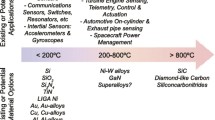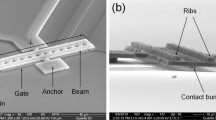Abstract
Stiction failures in microelectromechanical systems (MEMS) occur when suspended elastic members are unexpectedly pinned to their substrates. This type of device failure develops both in fabrication and during device operation, being a dominant source of yield loss in MEMS. Stiction failures require first a collapse force that brings the elastic member contact with the substrate followed by an intersolid adhesion sufficiently large to overcome the elastic restoring force. Stiction failure mechanisms have been studied extensively elsewhere [1]. This paper briefly summarizes these mechanisms in a the practical way. Over the last decade, stiction failure rates in MEMS have been minimized using a wide variety of processing, surface treatment, and physical schemes. An update of these methods is provided.
Similar content being viewed by others
References
C. H. Mastrangelo, “Adhesion related failure mechanisms in microelectromechanical systems,” Trib. Lett., vol. 3, pp. 223–238, 1997.
K. Chau, C. Fung, P. R. Harris, and G. Dahrooge, “A verstile polysilicon diaphragm pressure sensor chip,” in Int. Electron Devices Meeting, (IEDM 91), pp. 695–697, 1991.
D. W. Buurs, Micromechanics of Integrated Sensors and the Planar Processed Pressure Transducer. PhD thesis, University of Winsconsin, Madison, 1988.
J. M. Lysko, E. Stolarski, and R. S. Jachowicz, “Capacitive silicon pressure sensor based on the one-side wafer processing,” in Transducers’ 91, pp. 685–688, 1991.
J. T. Kung and H.-S. Lee, “An integrated air-gap capacitor process for sensor applications,” in Transducers’91, pp. 312–314, 1991.
W. Yun, R. T. Howe, and P. R. Gray, “Surface micromachined, digitally force-balanced accelerometer with integrated CMOS detection circuitry,” in International Workshop on Solid-State Sensors and Actuators (Hilton Head’ 92), pp. 126–131, 1992.
L. Ristic, R. Gutteridge, B. Dunn, D. Mietus, and P. Bennett, “Surface micromachined polysilicon accelerometer,” in International Workshop on Solid-State Sensors and Actuators (Hilton Head’ 92), pp. 118–121, 1992.
H. C. Nathanson and J. Guldberg, “Topologically structured thin films in semiconductor device operation,” Physics of Thin Films, vol. 8, pp. 251–298, 1975.
H. Guckel and D. W. Burns, “Fabrication of micromechanical devices from polysilicon films with smooth surfaces,” Sensors and Actuators, vol. 20, pp. 117–122, 1989.
J. N. Israelachvili, Intermolecular and Surface Forces. New York: Academic Press, 1985.
M. P. d. Boer, P. J. Clews, B. K. Smith, and T. A. Michalske, “Adhesion of polysilicon microbeams in controlled humidity ambients,” in Mat. Res. Soc. Symp. Proc., vol. 518, pp. 131–136, 1995.
C. H. Mastrangelo and C. H. Hsu, “Mechanical stability and adhesion of microstructures under capillary forces- parts I and II,” Journal of Microelectromechanical Systems, vol. 2, pp. 33–55, 1993.
C. H. Mastrangelo and C. H. Hsu, “A simple experimental technique for the measurement of the work of adhesion of microstructures,” in International Workshop on Solid-State Sensors and Actuators (Hilton Head’ 92), pp. 208–212, 1992.
E. W. Flosdorf, Freeze Drying: Drying by Sublimation. Ann Arbor, MI: University Microfilms International, 1982.
R. O. Holler, Freeze-Drying Biological Specimens. Washington, DC: Smithsonian Institution Press, 1979.
J. D. Mellor, Fundamentals of Freeze Drying. New York: Academic Press, 1978.
N. Takeshima, K. J. Gabriel, M. Ozaki, J. Takashashi, H. Horiguchi, and H. Fujita, “Electrostatic parallelogram actuators,” in Transducers’ 91, pp. 63–66, 1991.
G. T. Mulhern, D. Soane, and R. Howe T, “Supercritical carbon dioxide drying for microstmctures,” in Transducers’ 93, pp. 296–299, 1993.
C. J. Dawes, Introduction to Biological Electron Microscopy: Theory and Techniques. Burlington, VT: Ladd Research Industries, 1988.
H. Watanabe, S. Ohnishi, I. Honma, H. Kitajima, H. Ono, R. WIlhelm, and A. Sophie, “Selective etching of phosphosilicate glass with low pressure vapor hf,” J. Electrochem. Soc., vol. 142, pp. 237–243, 1995.
M. Wong, M. Moslehi, and R. Bowling, “Wafer temperature dependence of the vapor-phase hf oxide etch,” J. Electrochem. Soc., vol. 140, pp. 205–208, 1993.
J. Ruzillo, K. Torek, C. Daffron, R. Grant, and R. Novak, “Etching of thermal oxides in low pressure anhydrous HF/CHaOH gas mixture at elevated temperature,” J. Electrochem. Soc., vol. 140, pp. p. L64–L66, 1993.
T. Hirano, T. Furuhata, and H. Fujita, “Dry releasing of electroplated rotational and overhanging structures,” in International Conference on Micro Electromechanical Systems (MEMS 93), Fort Lauderdale, FL, U.S.A. Feb. 1993, pp. 278–283.
C. Mastrangelo and G. Saloka, “A dry-release method based on polymer columns for microstructure fabrication,” Proc. IEEE Micro Electro Mech. Syst. Workshop, Fort Lauderdale, FL, U.S.A. Feb. 1993, pp. 77–81.
M. Orpana and A. O. Korhonen, “Control of residual stress of polysilicon thin films by heavy doping in surface micromachining,” in Transducers’ 91, pp. 957–960, 1991.
F. Kozlowski, N. Lindmair, T. Scheiter, C. Hierold, and W. Lang, “A novel method to avoid sticking of surface micromachined structures,” Transducers’95, pp. 220–223, 1995.
H. V. Jansen, J. G. E. Gardeniers, J. Elders, H. A. C. Tilmans, and M. Elwenspoek, “Applications of fluorocarbon polymers in micromechanics and micromachining,” Sensors and Actuators, vol. A41–42, pp. 136–140, 1994.
T. Abe, W. C. Messner, and M. Reed, “Effective methods to prevent stiction during post-release-etch processing,” Proc. IEEE Micro Electro Mech. Syst. Workshop, Amsterdam, Neth, Feb. 1995, pp. 94–99.
G. Gould and E. A. Irene, “An in-situ study of aqueous HF treatment of silicon by contact angle measurement and ellipsometry,” J. Electrochem. Soc., vol. 135, pp. 1535–1539, 1988.
R. Williams and A. M. Goodman, “Wetting of thin layers of SiO2 by water,” Applied Physics Letters, vol. 25, pp. 531–532, 1974.
R. G. Frieser, “Characterization of thermally grown SiO2 surfaces by contact angle measurements,” J. Electrochem. Soc., vol. 121, pp. 669–672, 1974.
K. Hermansson, U. Lindberg, B. Hök, and G. Palmskog, “Wetting properties of silicon surfaces,” in Transducers’91, pp. 193–196, 1991.
D. Graf, M. Grunder, R. Schulz, and L. Muhlhoff, “Oxidation of hf-treated si wafer surfaces in air,” J. Applied Phys., vol. 68, pp. 5155–5161, 1990.
H. Watanabe, M. Hamano, and M. Harazono, “The role of atmospheric oxygen and water in the generation of water marks on the silicon surface in cleaning processes,” Mat. Sci. Eng., vol. B4, pp. 401–405, 1989.
M. Morita, T. Ohmi, E. Hagesawa, M. Kawakami, and K. Suma, “Control factor of native oxide growth on silicon in air or in ultrapure water,” Applied Physics Letters, vol. 55, pp. 562–564, 1989.
A. Ulman, An Introduction to Ultrathin Organic Films: From Langmuir-Blodgett to Self-Assembly. Boston: Academic Press, 1991.
R. Alley, R. T. Howe, and K. Komvopoulos, “The effect of release-etch processing on surface microstructure stiction,” in International Workshop on Solid-State Sensors and Actuators (Hilton Head’ 92), pp. 202–207, 1992.
M. Houston, R. Maboudian, and R. T. Howe, “Self-assembled monolayer films as durable anti-stiction coatings for polysilicon microstructures,” in International Workshop on Solid-State Sensors and Actuators (Hilton Head’ 96), pp. 42–47, 1996.
U. Srinivasan, M. R. Houston, R. T. Howe, and R. Maboudian, “Self-assembled fluorocarbon films for enhanced stiction reduction,” in Transducers’ 97, pp. 1399–1402, 1997.
B. P. Gogoi and C. H. Mastrangelo, “Adhesion release and yield enhancement of microstructures using pulsed lorentz forces,” Journal of Microelectromechanical Systems, vol. 4, pp. 185–192, 1995.
V. Kaajakari and A. Lal, “Pulsed ultrasonic release and assembly of micromachines,” in Transducers’ 99, pp. 212–215, 1999.
R. L. Alley, P. Mai, K. Komvopulos, and R. T. Howe, “Surface roughness modification of interfacial contacts in polysilicon microstructures,” in Transducers’ 93, pp. 288–291, 1993.
Y. Yee, K. Chun, and J. D. Lee, “Polysilicon surface modification technique to reduce sticking of microstructures,” in Transducers’ 95, pp. 206–209, 1995.
L.-S. Fan, Integrated Micromachinery–Moving Structures in Silicon Chips. PhD thesis, University of California, Berkeley, 1990.
W. C. Tang, T.-C. H. Nguyen, and R. T. Howe, “Laterally driven polysilicon resonant microstructures,” Proc. IEEE Micro Electro Mech. Syst. Workshop, Salt Lake City, Utah, U.S.A., Feb. 1989, pp. 53–59.
K. L. Johnson, K. Kendall, and A. D. Roberts, “Surface energy and the contact of elastic solids,” Proc. Royal Soc. London A, vol. 324, pp. 301–313, 1971.
K. L. Johnson, Contact Mechanics. New York: Cambridge University Press, 1987.
M. R. Houston, R. Maboudian, and R. T. Howe, “Ammonium fluoride anti-stiction treatments for polysilicon microstructures,” Transducers’95, pp. 210–213, 1995.
L. J. Hornbeck, “Digital light processing and MEMS: timely convergence for a bright future,” in Proc. SPIE Micromachining and Microfabrication Process Technology Conference, vol. SPIE 2639, pp. 1–21, 1995.
J. J. Licari, Plastic Coatings for Electronics. New York: McGraw-Hill, 1970.
H. Yasuda and T. Hsu, “Some aspects of plasma polymerization of fluorine containing organic compounds,” J. Polym. Sci. Polym Chem. Ed., vol. 15, pp. 2411–2424, 1977.
H. Yasuda and T. Hsu, “Some aspects of plasma polymerization of fluorine containing organic compounds. ii. comparison of ethylene and tetrafluoroethylene,” J. Polymer Sci., vol. 16, pp. 415–425, 1978.
H. Yasuda, Plasma Polymerization. New York: Academic Press, 1985.
P. D. Buzzard, Plasma Polymerization of Tetrafluoroethylene in a Field Free Zone. PhD thesis, University of California, Berkeley, 1978.
P. F. Man, B. P. Gogoi, and C. H. Mastrangelo, “Elimination of post-release adhesion in microstructures using thin conformal fluorocarbon films,” Proc. IEEE Micro Electro Mech. Syst. Workshop, San Diego, CA, U.S.A. Feb. 1996, pp. 55–60.
P. F. Man, B. P. Gogoi, and C. H. Mastrangelo, “Elimination of post-release adhesion in microstructures using conformal fluorocarbon films,” Journal of Microelectromechanical Systems, vol. 6, pp. 25–34, March 1997.
Author information
Authors and Affiliations
Rights and permissions
About this article
Cite this article
Mastrangelo, C.H. Suppression of Stiction in MEMS. MRS Online Proceedings Library 605, 105–116 (1999). https://doi.org/10.1557/PROC-605-105
Published:
Issue Date:
DOI: https://doi.org/10.1557/PROC-605-105




